Echeveria Black Prince Succulent Grow & Care Guide
Written by Iris
Nov 03 2021
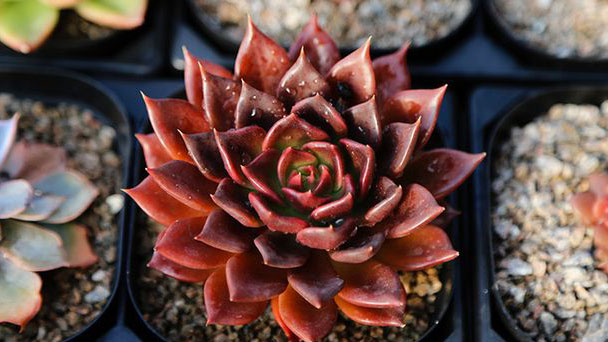
Echeveria Black Prince is a succulent genus of stone lotus of the Crassulaceae family. Spring and autumn are the periods of vigorous growth. Echeveria Black Prince likes a warm, dry environment. Echeveria Black Prince is not cold-resistant. Its favorite temperature is 18~25℃. Echeveria Black Prince is a full-day plant that needs plenty of sunlight, avoid strong light, and need to be properly shaded at noon in summer. The more light, the greater the temperature difference between day and night, and the darker and brighter the color of the leaves.
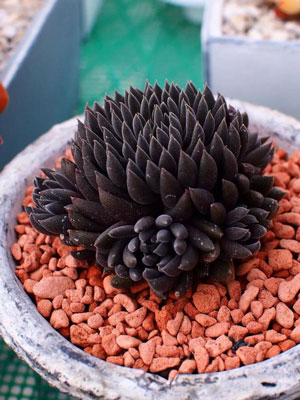
A south or west facing window will also work. You may need to do a little trial and error before you find the optimal spot for your Echeveria Black Prince Succulent. So be prepared to move it around a few times until you find a spot where it will be happiest.
Echeveria black prince succulent will not do well in dim areas for too long. Keep in mind that if the plant is not getting enough light indoors, you do not have to water the plant as much. Adjust watering by the amount of light it receives.
If your area does not receive adequate lighting no matter where you move the plant, consider using a grow light. Grow lights are a good investment to have especially if you have long, dark winters.
The plant achieves its gorgeous dark purple, almost black hue from increased sun exposure. The more intense the sun exposure, the deeper its color gets. Expect it to turn more greenish when kept in the shade.
Before moving the plant outdoors or increasing the amount of sunlight it receives, it is better to acclimate the plant to help prevent sunburn or sun damage. Slowly increase the amount of sunlight it receives until it is fully acclimated to the sun. Keep in mind that even when the plant is already acclimated to full sun, it can still get sunburned under intense summer heat or during a heatwave.
The best way to water Echeveria Black Prince Succulent is with the “soak and dry” method. This means you should only give the plant water when the soil is completely dry. You can assess the moisture level of the soil by touch or by inserting a stick. If the end of the stick comes out dry, it would be time to give the plant water.
Water the soil and avoid watering from the top. Do not get the leaves wet as it will place Black Prince at risk of being overwatered and succumbing to root rot.
Fungal disease can become an issue caused by overwatering.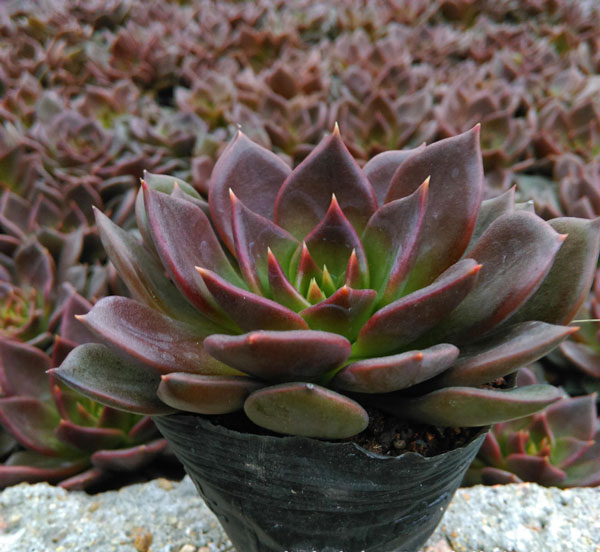
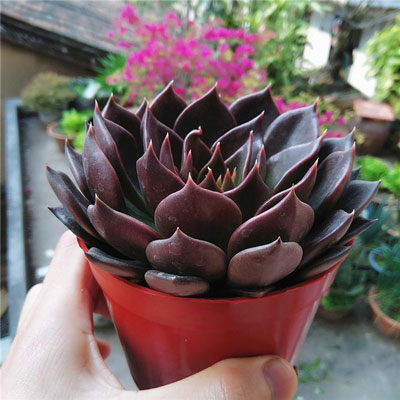
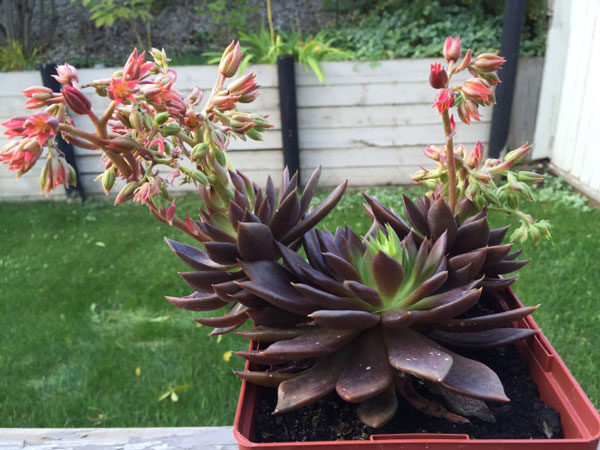
The flowers bloom in clusters and are red in color. They will thrive throughout winter.
Once you notice a discoloration in Echeveria Black Prince’s leaves or stems, cut the infected part of the plant with a sharpened and sterilized knife.
Remove the plant from the soil. Shake off excess soil and look for roots that are rotting. If you see any rotted roots, remove them right away and allow Black Prince to dry out completely.
Re-pot Echeveria Black Prince in a new container that is filled with fresh, well-draining soil.
You can keep pests out of the plant simply by removing dead leaves on its base. Then, spray Black Prince with neem oil.
If you see whitish, cotton-like substances on the leaves, these are by-products of the mealybugs. You can wipe these off with a cotton ball soaked in denatured alcohol.
Read Next:
Echeveria Elegans Mexican Snowballs Care & Growing Guide
Echeveria Laui (Echeveria Succulent) Care Guide
Echeveria Agavoides Care & Propagation
Echeveria Pulvinata (Chenille Plant) Care & Propagation Guide
Echeveria Nodulosa (Painted Echeveria) Care Guide
Echeveria Imbricata (Blue Rose Echeveria) Grow & Care Guide
Echeveria Setosa: Grow & Care for Mexican Firecracker
Echeveria Runyonii Topsy Turvy Grow & Care Guide
Echeveria Takasago No Okina Care Guide
Echeveria Mebina Care Guide
Where to Grow Echeveria Black Prince SucculentHow to Grow & Care for Echeveria Black Prince SucculentEcheveria Black Prince Care - LightEcheveria Black Prince Care - SoilEcheveria Black Prince Care - WaterEcheveria Black Prince Care - Temperature & HumidityEcheveria Black Prince Care - FertilizerEcheveria Black Prince Care - PruningEcheveria Black Prince Care - Pests & DiseasesHow to Propagate Echeveria Black Prince SucculentEcheveria Black Prince Propagation with OffsetsEcheveria Black Prince Propagation with Leaf CuttingsEcheveria Black Prince Succulent FAQIs Echeveria Black Prince Succulent Toxic for Cats and Dogs?Does Echeveria Black Prince Succulent Produce Flowers?Why is my Echeveria Black Prince Succulent Dying?
Where to Grow Echeveria Black Prince Succulent
Echeveria Black Prince succulent is not cold hardy, so if you live in a zone that gets colder than 20° F (-6.7° C), it's best to grow echeveria black prince succulent in a container that can be brought indoors. It does well in full to partial sun. Plant in an area of your garden that gets 6 hours of sunlight a day. If planting indoors, or bringing inside for the winter, place in a room that gets a lot of sunlight, such as near a southern-facing window (if you're in the Northern Hemisphere).
How to Grow & Care for Echeveria Black Prince Succulent
Echeveria Black Prince Care - Light
- Indoor Lighting Requirements
A south or west facing window will also work. You may need to do a little trial and error before you find the optimal spot for your Echeveria Black Prince Succulent. So be prepared to move it around a few times until you find a spot where it will be happiest.
Echeveria black prince succulent will not do well in dim areas for too long. Keep in mind that if the plant is not getting enough light indoors, you do not have to water the plant as much. Adjust watering by the amount of light it receives.
If your area does not receive adequate lighting no matter where you move the plant, consider using a grow light. Grow lights are a good investment to have especially if you have long, dark winters.
- Outdoor Sunlight Requirements
The plant achieves its gorgeous dark purple, almost black hue from increased sun exposure. The more intense the sun exposure, the deeper its color gets. Expect it to turn more greenish when kept in the shade.
Before moving the plant outdoors or increasing the amount of sunlight it receives, it is better to acclimate the plant to help prevent sunburn or sun damage. Slowly increase the amount of sunlight it receives until it is fully acclimated to the sun. Keep in mind that even when the plant is already acclimated to full sun, it can still get sunburned under intense summer heat or during a heatwave.
Echeveria Black Prince Care - Soil
If you are growing the Echeveria Black Prince Succulent outdoors, remember that they will flourish well in poor to average soil. However, the plant grows indoors is likely to thrive in cactus potting mix. If you could not find it, you may use a mixture of perlite/sand and potting mix. Like many other succulents, the soil of echeveria black Knight drains quickly, which helps prevent the moisture from rotting the roots.Echeveria Black Prince Care - Water
Echeveria Black Prince succulent is highly tolerant of drought. Typical of plants from the Crassulaceae family, this succulent can survive long periods without water.The best way to water Echeveria Black Prince Succulent is with the “soak and dry” method. This means you should only give the plant water when the soil is completely dry. You can assess the moisture level of the soil by touch or by inserting a stick. If the end of the stick comes out dry, it would be time to give the plant water.
Water the soil and avoid watering from the top. Do not get the leaves wet as it will place Black Prince at risk of being overwatered and succumbing to root rot.
Echeveria Black Prince Care - Temperature & Humidity
We do not recommend exposing Echeveria Black Prince Succulent to low temperatures for a long period. It is possible that it can withstand the occasional frost as long as it is adapted to the climate of your region. If you live in a region with winters in which the temperature drops below 0ºC, we recommend that you keep your plants in pots, in order to move them indoors during the coldest time of the year.Echeveria Black Prince Care - Fertilizer
Like some other succulents, Echeveria Black Prince Succulent does not require fertilizer. However, if you mix it in the soil, keep in mind that too much of fertilizer can burn the leaves of your plant. Therefore, add only a slow-release fertilizer in little quantity to your plant. Avoid adding fertilizer in winters and fall.Echeveria Black Prince Care - Pruning
Echeveria Black Prince Succulent naturally drops its old, lower leaves. If these leaves look clearly dead but are still hanging on, gently pull them off to maintain a clean look. Throw away the dead leaves as they can attract pests if left in the pot. Dying leaves caused by overwatering or rot should also be removed.Echeveria Black Prince Care - Pests & Diseases
The Echeveria Black Prince succulent is mostly disease-free. This hardy plant doesn’t have any significant pest problems. However, you should still watch for the common threats, such as aphids, mealybugs, and vine weevils. Remove these critters with soapy water, alcohol or Neem oil. Add the water and soap mixture to a spray bottle and lightly spray the leaves. You may also use a cotton ball to help with the removal process.Fungal disease can become an issue caused by overwatering.

How to Propagate Echeveria Black Prince Succulent
Echeveria Black Prince Propagation with Offsets
- Wait until the Echeveria Black Prince Succulent pups appear large enough to be removed. The pups are usually hiding under the plant or growing on the underside of the plant. Try to get some roots when removing the pup to give it the best chance at survival. Likewise, bigger pups are stronger than smaller ones and will have a better chance at surviving on their own.
- Remove the Echeveria Black Prince Succulent plant from the pot. It is better to remove the entire plant from the pot before separating the pup so you can see the entire plant including the roots. You may need to use a knife to remove the pup.
- Use a clean or sanitized knife and carefully separate the baby plant from its mother plant by inserting the knife blade between the mother plant and the offshoot. Slowly pull apart the pup from the mother plant and sever the connecting root.
- If removing the pup while still planted in the soil, insert the knife blade into the soil between the mother plant and the offshoot. Slide the blade down the soil to sever the connecting roots. Carve out a 2-inch radius in the soil around the base of the offshoot then dig a few inches down the radial parameter using the sharp end of a small spade. Insert the spade at an angle underneath the offshoot and carefully pry it loose from the soil to remove.
- Let the pup dry for about a day or more to make sure any cut or open areas are dry and sealed or calloused. Keep in a dry location away from direct sunlight.
- (Optional): Dip the pup in rooting hormone before planting. Rooting hormones can help speed this process up especially for pups without roots.
- Plant the pup. Once the pup is dry it can be planted on its own. Prepare a suitable well draining potting mix and plant the pup into the soil. Pack the soil lightly around the plant until secure.
- Water occasionally. Echeveria Black Prince Succulent pups need a little more moisture than mature plants. Lightly mist the soil with a spray bottle every few days or when the soil feels dry. Once the plant is more established and rooted, stop misting and water more deeply. You can decrease watering to about once a week or less.
- Protect from direct sunlight. Protect new Echeveria Black Prince Succulent plants from direct sunlight when initially planted on its own pot to prevent sun damage. Gradually increase sunlight and sun exposure according to the plant’s needs as the plant matures.

Echeveria Black Prince Propagation with Leaf Cuttings
- Obtain a few Echeveria Black Prince Succulent leaves preferably starting from the bottom of the plant. That way you don’t end up with a bald looking plant. It is best to use leaves that are plump and not shriveled or dehydrated. It is also best to use healthy looking leaves and not mushy, translucent ones. Since the stems are thin they shouldn’t take that long to dry. It is also a good idea to obtain cuttings from healthy looking plants, not dehydrated ones.Start off with a few leaves, not just one because you might lose a leaf or two along the way. Gently twist the leaf off the plant. Make sure to get the whole entire leaf, including the base or the leaf will not make it.
- Let the leaves dry for a couple of days. Keep in a bright, dry area away from direct sunlight.
- (Optional) Dip the cut end in rooting hormone. I usually skip this step but some people prefer using rooting hormones to speed up the process and also guarantee success.
- Once the cut has healed and dried, stick the leaf cuttings in a well draining potting mix or lay the leaf cuttings flat.
- Keep away from direct sunlight. Water or mist the soil every few days or when the soil feels dry.
- After about two weeks or so, you will notice new roots growing.
- After about four to six weeks, you will soon notice new growth developing from the leaves. Keep misting every few days or whenever the soil feels dry.
- Soon you will notice a baby Echeveria Black Prince Succulent plant emerge from the leaf. Some leaves will produce one plant, while other leaves will produce more than one. They’re all different. Keep in a bright location but away from direct sunlight.
- Leaf cuttings take a little longer but soon you will have yourself a big enough plant that you can transplant in its own pot to encourage it to keep growing into a mature plant.
- Once mature, you can increase the amount of sunlight it receives. Stop misting the Echeveria Black Prince Succulent plant as it gets bigger and can store more water. Water as you normally would once every 1-2 weeks depending on the humidity in your area.

Echeveria Black Prince Succulent FAQ
Is Echeveria Black Prince Succulent Toxic for Cats and Dogs?
Echeveria Black Prince succulent is not included in the list of plants that are toxic to cats and dogs that appear on the website of the American Society for the Prevention of Cruelty to Animals (ASPCA).Does Echeveria Black Prince Succulent Produce Flowers?
Yes, echeveria black prince produces flowers in the late fall or early winter months. You might see stems reaching up from its center as a sign that the plant is about to bloom.The flowers bloom in clusters and are red in color. They will thrive throughout winter.
Why is my Echeveria Black Prince Succulent Dying?
There are 2 possible causes for your Echeveria Black Prince succulent dying: Overwatering and Pest Infestation.- Overwatering
Once you notice a discoloration in Echeveria Black Prince’s leaves or stems, cut the infected part of the plant with a sharpened and sterilized knife.
Remove the plant from the soil. Shake off excess soil and look for roots that are rotting. If you see any rotted roots, remove them right away and allow Black Prince to dry out completely.
Re-pot Echeveria Black Prince in a new container that is filled with fresh, well-draining soil.
- Pest Infestation
You can keep pests out of the plant simply by removing dead leaves on its base. Then, spray Black Prince with neem oil.
If you see whitish, cotton-like substances on the leaves, these are by-products of the mealybugs. You can wipe these off with a cotton ball soaked in denatured alcohol.
Read Next:
Echeveria Elegans Mexican Snowballs Care & Growing Guide
Echeveria Laui (Echeveria Succulent) Care Guide
Echeveria Agavoides Care & Propagation
Echeveria Pulvinata (Chenille Plant) Care & Propagation Guide
Echeveria Nodulosa (Painted Echeveria) Care Guide
Echeveria Imbricata (Blue Rose Echeveria) Grow & Care Guide
Echeveria Setosa: Grow & Care for Mexican Firecracker
Echeveria Runyonii Topsy Turvy Grow & Care Guide
Echeveria Takasago No Okina Care Guide
Echeveria Mebina Care Guide
Latest Updated
- Benefits of Bugleweed - 7 Science-backed Health Benefits
- Bugleweed Dangers & Side Effects - Is It Poisonous?
- How to Plant Evergreen Trees - What You Should Know
- When to Plant Evergreens - Grow Guide for Evergreen Trees
- 12 Wonderful Evergreen Shrubs for Your Garden
- 12 Popular Evergreen Plants with Pictures for Beginners
- When And How To Prune A Lilac Bush Like a Pro
- How to Grow & Care for Lilac Vine (Hardenbergia Violacea)
- Japanese Lilac Tree (Syringa Reticulata) Care & Propagation Guide
- Shumard Oak Pros and Cons - What to Know
Popular Articles
- Winter maintenance of Antirrhinum Majus
- How to Grow Terminalia Mantaly Tree
- How to Grow and Care for Crossostephium Chinense
- How to grow Antirrhinum Majus in spring
- Peristeria Elata (Dove Orchid) Profile: Info & Care Guide
- Underwatered Snake Plant (Sansevieria Trifasciata) - Signs And How To Fix
- How to Care for Brazilian Jasmine Plant (Mandevilla Sanderi)
- How to Grow & Care for Graptopetalum Purple Delight in Summer
- Rosa Chinensis (China Rose): Plant Growing & Care Tips
- How to Care for Baby Sun Rose (Aptenia Cordifolia)